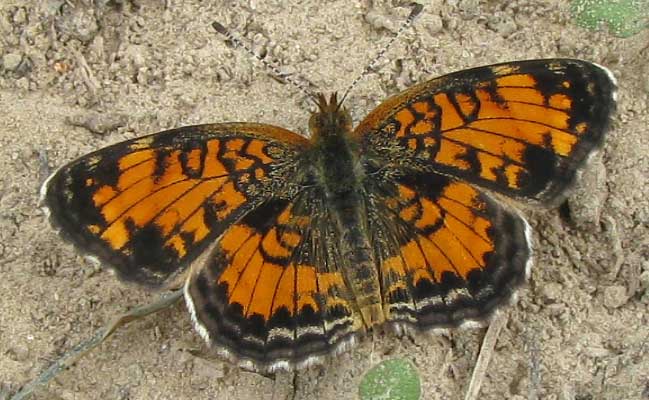Excerpts from Jim Conrad's
Naturalist Newsletter

from the March16, 2009 Newsletter, issued from the forest near Natchez, Mississippi; elevation ~400ft (120m), ~N31.47°, ~W91.29°:
PEARL CRESCENT ON A LEVEE
Several butterfly species have emerged here, most notably yellow sulfurs, white whites, and big, yellow- and-black Tiger Swallows. At St. Catharine NWR as we hiked down a grassy levee with water on both sides another famously early-emerging and conspicuous species took special interest in us. He'd land just ahead of us as we walked, then flit a little farther as we drew near, again and again. That's him above.
That's the Pearl Crescent, PHYCIODES THAROS, occurring from the Yukon south to southern Mexico, except for the US West Coast. With such a vast distribution area we can guess that there's a lot of variability in the species' appearance, or phenotype. That's true, especially with regard to the wings' black markings, some individuals being overall much darker than ours, some much less.
One constant throughout the species, however, is its "extrovert behavior," sometimes interpreted as curiosity, sometimes pugnaciousness, and sometimes pure recklessness. Writing from the Kentucky Bluegrass Region in 2006 I described Pearl Crescents as my "most common window-knocking species" -- the butterfly most likely to enter through the old farmhouse's broken-out windows, then knock against other window panes trying to get back out. They kept me busy shuttling them back outside. " ...often I just put a finger before them and more than likely they'll stick out their proboscises, discover how nicely salty my fingertip is, climb onto it as they sup, and ride it as I walk outside."
I read that Pearl Crescents lay their eggs on aster leaves, which its caterpillars later eat. The species' main habitats are moist meadows, fields, roadsides, streamsides and open places like our grassy levee.